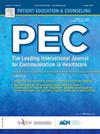Patient and contextual variables contribute to patients’ perception of general practitioners’ empathy
IF 3.1
2区 医学
Q2 PUBLIC, ENVIRONMENTAL & OCCUPATIONAL HEALTH
引用次数: 0
Abstract
Objectives
Patient-Perceived Physician Empathy (PPPE) is associated with positive outcomes for patients, quality of care and health expenditure. Research has often focused on physician-related predictors of PPPE, but barriers to empathy in general practice may also be contextual, such as lack of time, or patient-related, such as multimorbidity. Consequently, our aim was to explore the effect of these variables on PPPE.
Methods
In a cross-sectional design, 50 randomly recruited physicians included 20 consecutive adult patients with one or more chronic disease(s). Physician characteristics and work environment data were collected (e.g., gender, age, practice setting, caseload). Physicians filled in patients’ diseases, and patients filled in validated self-reported questionnaires on their health, emotional skills (i.e their ability to identify, express and regulate emotions) and their perception of ten physician empathic behaviours (CARE scale). Multilevel linear regressions were performed using SAS.
Results
The median PPPE score was 45 [possible range: 10—50] (n = 762), with higher rates in patients who had seven or more consultations with the physician in the last 12 months and lower in patients with genitourinary and upper gastrointestinal diseases. In consultations ≤ 20 min, the positive effect of longer consultations on PPPE was stronger in patients with low self-reported emotional skills, whereas patients with high self-reported emotional skills gave high ratings on the CARE scale, even in very short consultations of 5–10 min. Among the 11 physician-related candidate variables, only physician age slightly decreased PPPE.
Conclusions
Patient-related and contextual variables were associated with PPPE.
Practice implications
Consultations with infrequently seen patients and patients with low self-reported emotional skills should ideally last at least 20 min to allow the empathic process to unfold. Patients with genitourinary and upper-gastrointestinal diseases should be given special consideration, as they may encounter intimate issues or specific needs requiring more attention.
患者和环境变量有助于患者对全科医生共情的感知
目的:患者感知医师共情(PPPE)与患者的积极结局、护理质量和医疗支出相关。研究通常集中在与医生相关的PPPE预测因素上,但在一般实践中,移情的障碍也可能与环境有关,如缺乏时间,或与患者相关,如多重疾病。因此,我们的目的是探讨这些变量对PPPE的影响。方法采用横断面设计,随机招募50名医生,包括20名患有一种或多种慢性疾病的连续成年患者。收集医生特征和工作环境数据(如性别、年龄、执业环境、病例量)。医生填写病人的疾病,病人填写有效的自我报告问卷,内容包括他们的健康、情感技能(即他们识别、表达和调节情绪的能力)和他们对医生共情行为的感知(CARE量表)。采用SAS进行多水平线性回归。结果PPPE评分中位数为45分[可能范围:10-50](n = 762),过去12个月内就诊7次及以上的患者PPPE评分较高,泌尿生殖系统和上消化道疾病患者PPPE评分较低。在咨询≤ 20 min时,较长的咨询对PPPE的积极影响在自我报告情绪技能较低的患者中更强,而自我报告情绪技能较高的患者即使在非常短的咨询5-10 min中也给予较高的CARE评分。在11个与医生相关的候选变量中,只有医生年龄略微降低PPPE。结论患者相关变量和情境变量与PPPE相关。实践启示:与不常就诊的患者和自我报告情绪技能低的患者进行咨询,理想情况下应持续至少20 分钟,以使移情过程得以展开。泌尿生殖系统和上消化道疾病患者应给予特别考虑,因为他们可能会遇到亲密问题或需要更多关注的特殊需求。
本文章由计算机程序翻译,如有差异,请以英文原文为准。
求助全文
约1分钟内获得全文
求助全文
来源期刊

Patient Education and Counseling
医学-公共卫生、环境卫生与职业卫生
CiteScore
5.60
自引率
11.40%
发文量
384
审稿时长
46 days
期刊介绍:
Patient Education and Counseling is an interdisciplinary, international journal for patient education and health promotion researchers, managers and clinicians. The journal seeks to explore and elucidate the educational, counseling and communication models in health care. Its aim is to provide a forum for fundamental as well as applied research, and to promote the study of organizational issues involved with the delivery of patient education, counseling, health promotion services and training models in improving communication between providers and patients.
 求助内容:
求助内容: 应助结果提醒方式:
应助结果提醒方式:


